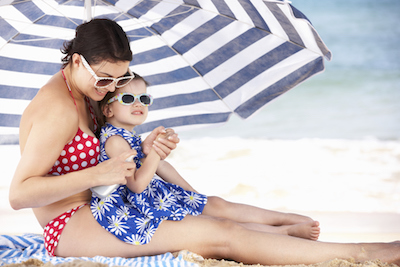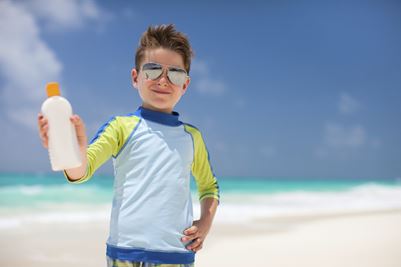What every parent needs to know about protecting children from the sun
During the summer months, I am often asked by parents about sun protection. There are many products and sunscreens available, and it can often be challenging to determine what products are best for your child.
Why is sunscreen necessary?
All children should be encouraged to go outside and play. Children are often inside playing video games and watching television, but it’s essential to remember that physical activity is important for your child's overall health. Active play also is important for childhood development. In order to keep your child healthy while playing outside, your child needs to be protected from the sun.
The sun produces ultraviolent radiation commonly referred to as UV. UV rays vary by geographical location, season, and time of day. There are both UVA and UVB rays. UVA rays remain at a constant level while UVB rays are greater when it is warmer out, such as in the summer and around noon time each day. UVB rays are also increased in areas closer to the equator. UV rays also are reflected by certain surfaces, such as water and concrete. When UV rays are reflected, the exposure to the sun is increased.
UV ray exposure can cause redness of the skin that is commonly called sunburn. When your skin tans, it is your skin's response to UV rays to protect your skin cells. Medical research studies have also shown that exposure to UV rays can cause skin cancer.
Skin is not the only part of your body that may be damaged by the sun. Your eyes can also sustain damage by being exposed to UV rays.
How to protect infants from the damaging effects of the sun
 If your child is less than 6 months old, avoiding the sun is your best approach. In order to protect them from the sun’s rays, keep them out of direct sunlight and place them under shaded areas. Here are some ideas to help you provide shade for your baby:
If your child is less than 6 months old, avoiding the sun is your best approach. In order to protect them from the sun’s rays, keep them out of direct sunlight and place them under shaded areas. Here are some ideas to help you provide shade for your baby:
- - Attach a canopy for your stroller
- - Dress your child in hats with wide brims that extend past their ears and nose
- - Bring an umbrella when you know that it will be difficult to find a shady spot, such as when you are at the beach or park
- - If shade is unavailable, you can use sunscreen sparingly on the face.
Keep in mind that the sun is very hot for your little one. While in the sun, use lightweight clothing to keep your baby cool. While fluffy baby blankets and thick onesies make your child look adorable, they are often making your baby extremely hot.
Tips to keep children protected while playing outdoors
- Sunglasses can be used for all children (and adults!). Many companies make child-sized sunglasses. When shopping for shades for your child, look for a “UV protection” sticker or label on the packaging. The UV protection is also often given a number. Make sure you select one that says at least 97-99%. This means that it protects your eyes from at least 97-99% of the UV rays.
Clothing can be used to protect your child from UV rays. When selecting sun-protective clothing for your child, keep the following in mind:
- Preferred styles are clothing that covers your child's neck, arms up to their elbows, and legs down to their knees
- Dark-colored clothing is more protective than light-colored clothing
- Tighter weave clothing prevents the sunrays from reaching your child’s skin.
- How can you tell? Hold it up to the light; if you cannot see light through it, it is tighter woven fabric. Cotton is a good example of a fabric that is tightly woven.
- Some manufacturers make clothing with UV protection in the fabric. These fabrics use a grading system called UV protection factor (UFP).
- UFP ranges from 15 to 50 (or more). The higher the UFP, the greater the UV protection.
Get to know your sunscreen
When selecting a sunscreen, remember that not all brands are created equal. There are several things to consider in order to select an appropriate and effective sunscreen.
1) Sun Protection Factor (SPF)
- SPF grading tells you the protection you get from using the sunscreen.
- For example: If your skin burns from 10 minutes of sun exposure, SPF 30 protects your skin for 30 X 10 minutes. That's 300 minutes of sun protection.
- In reality, this protection is less than calculated because most people do not apply enough sunscreen.
- In order to have effective sun protection while using sunscreen, ensure that you are using at least SPF 15. I usually recommend SPF 15-30.
2) UVA vs UVB
- Sunscreen bottles often are labelled with UVA or UVB protection.
- Make sure you select one that says “broad spectrum” because that protects from both UVA and UVB.
3) Zinc oxide acts as a barrier from the sun. Some sunscreens contain zinc oxide or you can use zinc oxide separately. It is great for areas that are at most risk for sunburn, such as your child’s nose, cheeks, and ears.

How to use your sunscreen
- - Apply sunscreen at least 30 minutes prior to going outside
- - Apply any time you are going to be outside
- - Cover all sun-exposed areas liberally
- - Reapply least every 2 hours or after swimming or sweating
- - I suggest setting a timer on your cellphone or downloading a sunscreen reminder application for your smartphone that will remind you to reapply!
- - When reapplying, be generous! It is always better to apply a bit too much than not enough.
And remember, the sun is strongest during the middle of the day.
If you are going to have your child in the sun, try to take a midday break in the shade. And during your break, make sure you reapply!






